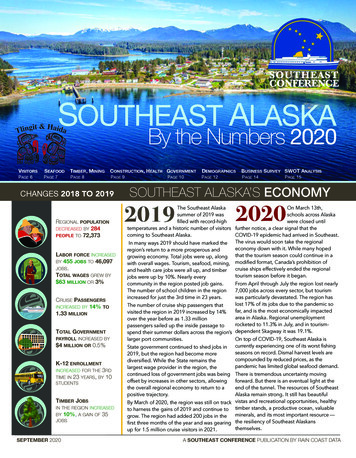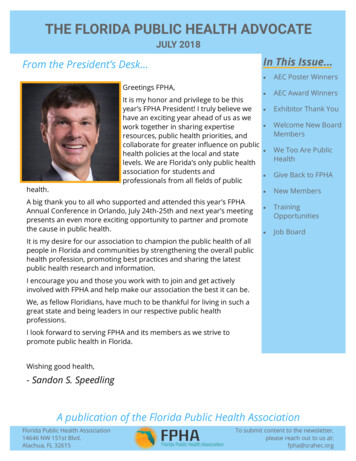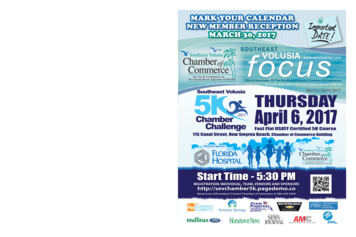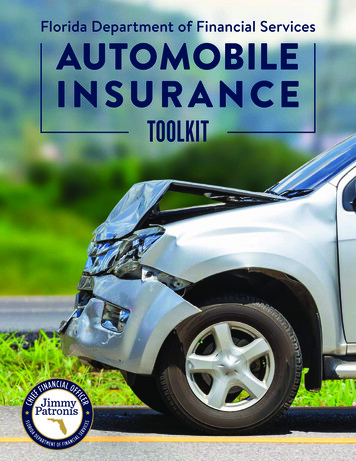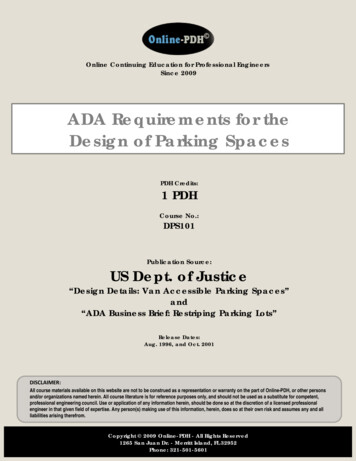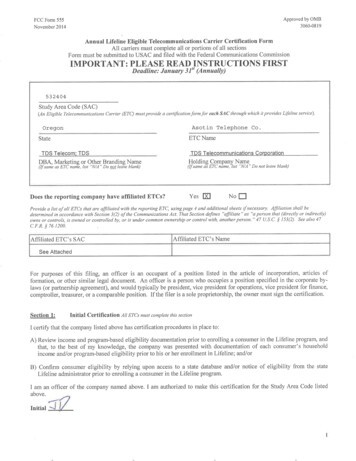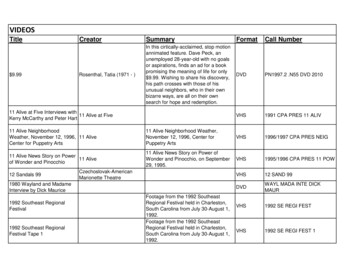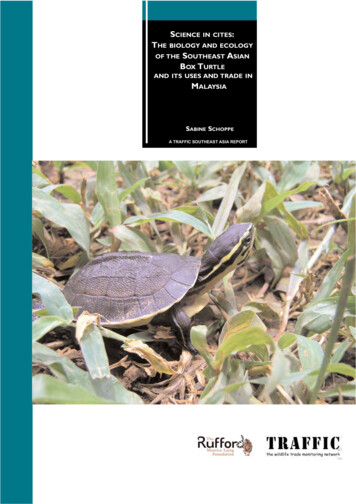
Transcription
Nature-Based Coastal Defensesin Southeast FloridaPublished byINTRODUCTIONMiami Beach skyline Ines Hegedus-Garcia, 2013Assessments of the world’s metropolitan areas with themost to lose from hurricanes and sea level rise placesoutheast Florida at the very top of their lists. Muchinfrastructure and many homes, businesses and natural areasfrom Key West to the Palm Beaches are already at or near sealevel and vulnerable to flooding and erosion from waves andstorm surges. The region had 5.6 million residents in 2010–apopulation greater than that of 30 states–and for many of thesepeople, coastal flooding and erosion are not only anticipatedrisks of tomorrow’s hurricanes, but a regular consequence oftoday’s highest tides.Billions of dollars in property value may be swept away in onestorm or slowly eroded by creeping sea level rise. This doublethreat, coupled with a clearly accelerating rate of sea levelrise and predictions of stronger hurricanes and continuedpopulation growth in the years ahead, has led to increasingdemand for action and willingness on the parts of the publicand private sectors to be a part of solutions. Practical people andthe government institutions that serve them want to know whatthose solutions are and what they will cost.Traditional “grey infrastructure” such as seawalls andbreakwaters is already common in the region but it is not theonly option. Grey infrastructure will always have a place hereand in some instances it is the only sensible choice, but it hassignificant drawbacks. These include negative impacts onthe natural environment, high initial construction costs andsignificant replacement costs.Hurricane Sandy approaching the northeast coast of the United States. NASAThis narrow beach could not stop Sandy’s waves but it sheltered State RoadA1A and these homes. South Florida Sun-Sentinel
John U. Lloyd Beach State Park Dune Restoration ProjectNature-Based Coastal Defenses in Southeast FloridaINTRODUCTIONBy comparison, natural or nature-based coastal defenses can be cost-effective, self-maintaining and adaptable to changingconditions including sea level rise. They are designed and constructed to work in harmony with the natural environment. Inmany instances they simply are the environment.Southeast Florida’s coral reefs, beaches, dunes, wetlands and coastal forests are well known for the critical habitat they providefor wildlife and are understood to be an integral part of the diverse mix of attractions that anchors the region’s tourism and realestate-driven economy.Southeast Florida’s leaders are beginning to appreciate and understand the value of the coastal protection services that naturalfeatures provide to us at no cost. As a result, they are investing in the protection and restoration of marine and coastal naturalareas, as well as exploring nature-based constructed projects to shore up what we now recognize as the front lines of our defenseagainst storms.The seven case studies in this packet were compiled by The Nature Conservancy and the Southeast Florida Regional ClimateChange Compact to spotlight the role of natural and nature-based approaches to coastal defense. A diverse set of project typesand sizes was selected from locations across the region. Case study project leaders include county and municipal governmentsand a not-for-profit conservation organization working with a consortium of public and private players. These case studies arerepresentative of numerous other excellent projects that have been completed in southeast Florida.Perhaps most importantly, these case studies are representative of projects that have yet to be conceived and implemented. TheNature Conservancy and the Compact are developing a catalogue of new project opportunities based on cutting-edge scienceand local knowledge. In order to become a reality, every potential project will need a champion who recognizes the value ofnature in protecting our coastal communities from storms and sea level rise.
Nature-Based Coastal Defensesin Southeast FloridaPublished byPROJECT LOCATOR MAPCoral Cove Park DuneRestorationSnook Islands Natural Area HabitatEnhancementJohn U. Lloyd Beach StatePark Dune RestorationWest Lake Park Mitigationand RestorationMiami Beach Dune Restorationand EnhancementVirginia Key North PointEcosystem RestorationFlorida Keys Coral RestorationThese seven case studies represent a range of natural or nature-based projects that mitigate the effects of flooding anderosion in southeast Florida. Some of the projects involved restoration of native species populations or natural featuresthat had been degraded or lost over time. Others created entirely new coastal features by combining natural materialsand native species in novel constructions. Some were designed with coastal defense objectives squarely in mind and otherswere not. But whether large or small or complex or simple, every one of these projects left the natural world and nearby coastalcommunities in better shape than it found them.To access the full report, visit nature.org/southeastfloridareportMiami skyline. Ines Hegedus-Garcia., 2013
Nature-Based Coastal Defensesin Southeast FloridaPublished byPROJECT DESCRIPTIONPROJECTTotal AcresCoral Cove Dune Restoration Project20 acresSnook Islands Natural Area Habitat Enhancement Project70 acresJohn U. Lloyd Beach State Park Dune Restoration Project2.5 acresWest Lake Park Mitigation and Restoration Project27 acresMiami Beach Dune Restoration and Enhancement Project54 acresVirginia Key North Point Ecosystem Restoration Project17 acresICON KEYFlorida Keys Coral Restoration Project1 acreCoastal WetlandBreaks waves along the shoreline, providescritical habitat for fish, invertebrates andother wildlifeStructureRiprap or other constructed shoreline featuresthat protect from waves and erosionCoral ReefBreaks waves offshore, provides criticalhabitat for fish and invertebrates, providestourism and recreational opportunitiesBeach/DuneBreaks waves along the shoreline, provideshabitat for turtles, birds and other wildlife, andprovides tourism and recreational opportunitiesOyster ReefBreaks waves offshore, provides criticalhabitat for fish and invertebrates, improveswater quality via filtration
Nature-Based Coastal Defenses in Southeast FloridaPublished byCoral CoveDune Restoration ProjectHealthy dunes are a vital component of the coastal ecosystem that naturally protects shorelines from storm erosion.Native salt-resistant dune vegetation traps windblown sand and collects it around plants, which builds dunes andsurrounding beaches. Dunes also provide a reserve supply of sand to replenish beaches during times of severe erosion.This process is critical to maintaining beautiful beaches that are attractive to residents and tourists alike. In 2013, more than 1.5million people visited Palm Beach County’s beaches. While there, those visitors spent an estimated 160 million.Coral Cove is a popular beachfront park on Jupiter Island. Its shoreline has one of the highest density nesting beaches in the statefor threatened and endangered sea turtles and is part of the 31 miles designated as critically-eroded in Palm Beach County. Thedune there has been impacted by storm erosion over the past twenty years. In 2012, the dune suffered severe erosion as a resultof Hurricane Sandy, putting upland infrastructure and private homes at risk. The eroded beach-dune system also restricts visitorsfrom accessing and enjoying the park, and detrimentally affects the abilities of sea turtles to safely nest.In order to maintain a healthy beach-dune system, periodic dune restoration projects must be constructed in eroded areas. Beachcompatible sand is trucked in from an inland mine and added to the dune. Heavy equipment then grades the sand into a naturaldune profile. Finally, native dune vegetation is planted to create habitat and help hold the sand in place. Over 83,000 cubic yardsof sand and more than 150,000 native dune plants have been placed as part of five different restoration projects within the parksince 1989.FAST FACTS:Completed dune planted with sea oats Palm Beach County Environmental Resource ManagementProject cost: 775,000Project size: 20 acresAdditional information about Coral Cove can be found by theastfloridareport
John U. Lloyd Beach State Park Dune Restoration ProjectCoral Cove Dune Restoration ProjectDune Damaged by Hurricane Sandy, October 2012 Palm Beach County Environmental Resource ManagementDune restoration in progress Palm Beach County Environmental Resource ManagementCompleted dune restoration Palm Beach County Environmental Resource ManagementPARTNERS
Nature-Based Coastal Defenses in Southeast FloridaPublished bySnook Islands Natural AreaHabitat Enhancement ProjectThe Lake Worth Lagoon (LWL) in Palm Beach County was previously a freshwater lake fed by water from the Evergladesto the west. In the 1870s, a permanent oceanic inlet was established near Palm Beach converting the freshwater lakeinto an estuarine system. Mangroves and other estuarine flora and fauna took over the lagoon. Over the next 100 years,however, the Lake Worth Lagoon experienced a significant assault on its natural resources. Dredging, filling and bulkheadconstruction eliminated over 80 percent of the mangrove fringe and much of the lagoon’s intertidal and shallow sub-tidalresources. Productive fish and wildlife habitat was almost completely eliminated. Currently, approximately 65 percent of thelagoon shoreline is bulkheaded, and less than 20 percent of the shoreline remains fringed by mangroves.In an effort to reverse the damage to the LWL, Palm Beach County Environmental Resource Management has initiated a numberof enhancement projects to recreate some of the lost fish and wildlife habitat. One of these is the Snook Islands Natural Areahabitat enhancement and erosion control project completed in 2005. Approximately 1.2 million cubic yards of spoil were minedfrom the Peanut Island spoil stockpile, transported 10 miles by barge (1,560 barge loads), and used to raise the elevation of a deepdredged hole created in 1925 when a nearby golf course was constructed. This hole had accumulated very fine organic sediments(muck) and created an anoxic environment providing little fish and wildlife habitat value onshore, major sections of the golfcourse’s seawall had failed, and the upland was eroding into the LWL.Project construction resulted in creation of 10 acres of red mangroves, 2.8 acres of Spartina marsh, 2.3 acres of oyster reef and nearly 50acres of seagrass recruitment area. Constructing the offshore mangrove islands and oyster reefs created valuable fish and wildlife habitatand provided a buffer against waves and boat wakes precluding the need to construct a new seawall for shoreline protection.A seagrass survey conducted in 2010 revealed that seagrasses had covered more than 87 percent of the project area at an averagedensity of 30.4 percent. The mangroves and smooth cordgrass are thriving and provide excellent fish and wildlife habitat. Oystersare recruiting to the riprap and reef pods—limestone rock piles intentionally placed at the optimum elevation to recruit oysters—at densities equaling the naturally occurring reefs in the lagoon. A pair of rare American oystercatchers has nested at SnookIslands every year since construction. They have produced 12 fledged chicks in the past nine years, and a new pair began nestingthis year.FAST FACTS:Snook Islands, 2011 Palm Beach County, ERMProject cost: 17,000,000Project size: Approximately 70 acresAdditional information about Snook Island can be found by ne/snook/www.nature.org/southeastfloridareport
John U. Lloyd Beach State Park Dune Restoration ProjectSnook Islands Natural Area Habitat Enhancement ProjectSnook Islands shoreline, 2011 Palm Beach County, ERMSnook Islands mangrove island at high tide, January, 2013 Palm Beach County, ERMFill being placed and graded at Snook Islands, 2004 J.E. McAmis Inc.Snook Islands shoreline, 2011 Palm Beach County, ERMPARTNERSWOFLAKE
Nature-Based Coastal Defenses in Southeast FloridaPublished byJohn U. Lloyd Beach State ParkDune Restoration ProjectBroward County has a total of 24 miles of shoreline, 21 miles of which is designated as critically eroded. The shoreline atJohn U. Lloyd Beach (JUL) State Park is of particular concern because it is subject to the influences of Port EvergladesInlet channel and jetties. These navigation features form a complete barrier to sand transport. Consequently, the beachesat JUL are severely eroded. A series of expensive and short-lived beach renourishment projects were undertaken along thepark’s shoreline to offset that erosion. Accordingly, the community is looking to implement more lasting shoreline managementstrategies, such as the restoration of sand dunes, to make their beaches resilient.The goals of the project were to improve community awareness about the importance of dune features as part of a regionalshoreline management strategy and to demonstrate the power of teamwork and community engagement in the restoration ofsand dunes at JUL. The involvement of community youth fostered a sense of personal accomplishment and awareness of theimportance of environmental stewardship, and helped instill an appreciation for shoreline resilience strategies. To undertakethis project, local students and community volunteers were provided with instruction and hands-on training in shorelineresiliency, beach erosion, beach and dune ecology and proper dune vegetation planting. Afterwards, Broward County staff, YouthEnvironmental Alliance (YEA) and the park service worked with the volunteers to prepare and fence off the sites to be restored.Over the course of four events, volunteers planted more than 7,000 sea oats in the fore dune to mitigate future beach erosion.Additionally, more than 1000 native dune plants of 14 different species were planted in the mid and back dune to diversify theplant community and improve the ecological function of the dune.The success of the JUL Beach State Park Dune Restoration Project continues to resonate in the community. YEA has formedpartnerships with the Town of Lauderdale-By-The-Sea in Broward County, the Town of Surfside in Miami-Dade County andBoca Raton in Palm Beach County to conduct additional community volunteer-based dune restoration projects.The JUL Beach State Park Dune Restoration Project is an example of a successful partnership between government, a non-profit andcorporate sector who share common goals in promoting sustainable environmental programs and developing resilient communities.The project was funded by a 2013 Keep America Beautiful/Waste Management ThinkGreen Grant.Victor Suarez and Sea Oats Broward County EPCRD, 2013FAST FACTS:Dunes and Rainbow David StoutProject cost: 10,000Project size: 2.5 acresNew Sea Oat Plantings David StoutAdditional information about John U. Lloyd can be found by org/news.htmwww.nature.org/southeastfloridareport
John U. Lloyd Beach State Park Dune Restoration ProjectJohn U. Lloyd Beach State Park Dune Restoration ProjectPARTNERS
Nature-Based Coastal Defenses in Southeast FloridaPublished byWest Lake Park Mitigationand Restoration ProjectIn 2011, Broward County completed a 10 million mitigation and coastal habitat restoration project to replace 15 acres ofwetland habitat lost when Fort Lauderdale-Hollywood International airport expanded their facilities. To offset the impactsof the airport development, new habitat was created and degraded habitat was improved at nearby West Lake Park.The first step of this project was the removal of invasive, non-native Australian pines that were brought to this area at the turnof the 20th century. Over the past hundred-plus years, the invasive, fast spreading trees overtook natural habitats and displacednative wildlife within the park. Hydrologic improvements were then made by grading restoration sites to specific depths thatcreated five ecotones: channels, mangroves, mudflats, hammocks and tidal pools. This facilitated natural recruitment andgermination of mangroves and other aquatic vegetation. The installation of a 4,700-foot riprap (rock) crib reduced wave action,protecting the shoreline from erosion while still allowing water exchange. Additionally, the riprap crib provides habitat forjuvenile fish, marine invertebrates and the birds that prey on them.Overall, the coastal habitat restoration included: Removal of 3.5 acres of invasive vegetation and planting of native vegetation Creation of 13 acres of mangrove wetlands Stabilization and enhancement of seven acres of mangrove through riprap crib structure Acquisition and preservation of 4.25 acres of additional park landThe unique nature of this mitigation and habitat restoration project received widespread attention from environmental groupsand regulatory agencies nationwide. The project has been so successful that it is now used by the University of Florida in itsMaster Naturalist Program training classes.West Lake Park is the largest remaining mangrove system in the 85-mile, highly developed urban coastal zone from MiamiBeach to West Palm Beach. This vital coastal habitat provides valuable natural resource functions and significant recreationalopportunities to urban residents and visitors.FAST FACTS:Riprap crib and hammock planting Paul Krashefski, Broward County, EPCRD, 2011Project cost: 10 millionProject size: 27 acresAdditional information about West Lake Park can be found by report
John U. Lloyd Beach State Park Dune Restoration ProjectWest Lake Park Mitigation and Restoration ProjectRiprap crib mangrove hammock close up Paul Krashefski, Broward County, EPCRD, 2011Riprap crib Paul Krashefski, Broward County EPCRD, 2011PARTNERS
Nature-Based Coastal Defenses in Southeast FloridaPublished byMiami Beach Dune Restorationand Enhancement ProjectBetween 1975 and 1980, the United States Army Corps of Engineers (USACE) and the Florida Department ofEnvironmental Protection (FDEP) fortified the City of Miami Beach’s eastern shoreline as part of the Beach ErosionControl and Hurricane Protection Project. The scope of the project included using offshore sand to nourish the beachesand to construct a non-vegetated levee. In the mid-1980s, the sand levee, or sand dune, was vegetated by FDEP to improveits protective function, creating the vegetated dune that exists today. In the past, the city’s dune system was not on a dedicatedmaintenance schedule, so vegetation in certain areas became overgrown and created favorable conditions for homelessencampments and illicit activities. In addition, non-native invasive vegetation grew aggressively and crowded out native species,increasing the potential for erosion and decreasing the system’s ability to withstand sustained wind and wave action.In 2013, the city, in coordination with a professional dune ecologist, developed a citywide dune restoration and enhancementproject to restore the health and structural integrity of the entire dune system and to fortify it in advance of the 2014 hurricaneseason. The project consisted of removing non-native dune vegetation and replanting cleared areas with native species in SouthBeach (Government Cut to 3 Street and 14 Street to 23 Street), Middle Beach (23 Street to 47 Street), and North Beach (64Street to 79 Street). Additionally, the city trimmed select native vegetation in order to foster low growth and stabilize existingvegetation. The city retained two landscape contractors through an open bid process to complete this work. Areas not addressedby this project will be restored in the future during the construction of the adjacent beachwalk or as part of continued volunteerdune restoration efforts.The project maximized the dune’s ability to protect inland properties from storm surge and provide critical erosion control tothe beach. The healthier dune system also provides better habitat for native plants and animals and is more structurally sound.Resulting conditions in the dunes have also greatly reduced security and crime concerns that had previously plagued the city.Moving forward, the city will place the dunes under a maintenance contract, in which a landscape contractor will maintain theentire system 30 times per year to prevent it from returning to its pre-project state.FAST FACTS:South Pointe Park dunes before the project Ariel Moger.Project cost: 300,000, with an on-going maintenance costof approximately 111,000 per year.Project size: approximately 54 acres, with 1.34 acres forcontinued volunteer restoration projects and 1.92 acres tobe restored as part of future capital projects.1.92 acres to berestored as part of future capital projects.South Pointe Park dunes after the project Ariel Moger.Additional information about Miami Beach can be found by ental/scroll.aspx?id 78915www.nature.org/southeastfloridareport
John U. Lloyd Beach State Park Dune Restoration ProjectMiami Beach Dune Restoration and Enhancement ProjectCity of Miami Beach: CItywide Dune Restoration Services ProjectµNorth BeachMiddle BeachSouth Beach BLegendProject AreasSouth Beach AWaterBeachPARTNERS
Nature-Based Coastal Defenses in Southeast FloridaPublished byVirginia Key North PointEcosystem Restoration ProjectVirginia Key is a 1,000-acre barrier island containing a variety of upland and wetland plant communities including seagrass beds and inter-tidal sand/mud flats, mangrove wetlands, beach dune communities and coastal maritime hammock.The island is located in Biscayne Bay, south of Fisher Island and bordering the Atlantic Ocean. The City of Miamiis the present landowner of the north point of Virginia Key, and the Park and Recreation Department manages the park sitefor the City. On July 22, 2010, the City of Miami approved a comprehensive master plan for Virginia Key that is guiding thedevelopment of public park space and natural areas on the north point of the island.Through mitigation and environmental grant funds already secured, the City of Miami, in partnership with Miami-Dade County(MDC), the Miami Science Museum (MSM) and other City Park nonprofit partners will restore and enhance approximately 17acres of coastal habitat consisting of hammock, coastal strand, beach dune, and freshwater wetlands communities on the northernend of Virginia Key. While the island is non-residential and most of it is undeveloped, the Miami-Dade County Central DistrictWastewater Treatment Plant is located southwest of the project site. This project will enhance a segment of the coastal bufferwhich provides the front line of defense against erosion and other storm impacts on the facility.The island contains more than 300 acres of mangroves, approximately 18 acres of coastal hammock (one of the rarest plantcommunities in the county due to coastal development), and 16 acres of beach and dune communities. Virginia Key provideshabitat for ten endangered/threatened plant and animal species. Virginia Key and all of the barrier islands along South Florida havehistorically provided prime turtle nesting habitat due to the prevalence of sandy beach habitat. However, due to coastal developmentand light pollution, limited historic sea turtle habitat remains in South Florida. Invasive non-native plants, such as Australian pinehave colonized landward swaths of beach where turtles historically nested, thereby limiting the width of beach available for nestingfemales to lay their nests. The proposed restoration effort will significantly enhance endangered species habitat on Virginia Keyfor endangered reptiles, insects, plants and birds. The restoration will involve the selective clearing and grubbing of all non-nativevegetation, the creation of beach dune and coastal hammock habitat by moving and grading existing fill, the enhancement of anexisting isolated freshwater wetland on-site through non-native vegetation eradication and control, the planting of appropriatenative vegetation within each of the restored plant communities by volunteers from the local community, and the creation of trailswith interpretive signage through the restored habitats to provide passive recreational opportunities.The project will be phased and conducted over a two-year period to allow for the outreach, education, and volunteer plantingduring two rainy seasons. The objective of the project is three-fold 1.) to restore and enhance the ecological habitats for a widevariety of native fauna, 2.) to provide environmental education to the local community, 3.) and to provide additional recreationalopportunities on the North Point of Virginia Key. As stipulated by the Virginia Key Master Plan, Virginia Key’s North End willbe one of the few multi-use spaces of its kind in South Florida by providing recreational and conservation spaces.FAST FACTS:Nonnative and invasive vegetation dominate the landscape prior torestoration and the beach area located landward of the MHW has beenaltered by placement of dredged fill, solid waste, and the subsequentcolonization by invasive plants Josh Mahoney, Miami-Dade County RER/DERM.Project cost: 400,000Project size: Restoration and enhancement ofapproximately 17 acres of coastal habitat. To date,4.4 acres of dune have been restored.Virginia Key Restored Dune Josh Mahoney, Miami-Dade County RER/DERMAdditional information about Virginia Key can be found by w.nature.org/southeastfloridareport
John U. Lloyd Beach State Park Dune Restoration ProjectVirginia Key North Point Ecosystem Restoration ProjectVirginia Key North Point Dune andCoastal Hammock Restoration SitePARTNERS
Nature-Based Coastal Defenses in Southeast FloridaPublished byFlorida KeysCoral Restoration ProjectHealthy coral reefs provide benefits to marine life and people alike. Reefs provide essential habitat to commercially andrecreationally important fish species as well as thousands of species of invertebrates. They also are frequented by largermarine predators such as sharks, sea turtles and dolphins. Because of their beauty, high diversity and abundant marinelife, reefs attract people for fishing, snorkeling and diving. More than 33,000 jobs in Monroe County are supported by oceanrecreation and tourism, accounting for more than half of the local economy.Intact reefs also provide a barrier for ocean waves, causing them to break offshore rather than on the coast. A global study byThe Nature Conservancy shows that coral reefs that crest at the surface reduce up to 97 percent of wave energy and are a costeffective option when comparing natural reef enhancements to other options like breakwaters and seawalls. This has importantimplications for South Florida, which has the longest reef tract in the continental United States.Coral reefs in the Florida Keys have been in decline since the 1970s due to stresses including coral bleaching, disease outbreaks,hurricanes and cold snaps, as well as acute impacts such as ship groundings. Populations of elkhorn and staghorn coral underwenta region-wide decline with losses of up to 97% in some areas. Measures are being taken in Monroe County to help protect thehealthy coral that remains. However, habitat protection and threat reduction may not be enough to stop the decline of reefs.Active restoration of coral populations is now a feasible and cost-effective way to reestablish live coral to reefs.A collaborative effort funded by NOAA and The Nature Conservancy and implemented by a consortium of project partnersis working to restore genetically diverse, breeding populations of threatened staghorn and elkhorn corals to degraded reefsthroughout South Florida and the U.S. Virgin Islands.Tens of thousands of staghorn corals are being grown and propagated in underwater nurseries, and then outplanted to degradedreefs off Monroe County. The project’s primary restoration and recovery approach is to take small fragments of live tissue fromhealthy coral colonies of known genetic stock, grow them in nurseries over time to create multiple colonies of each genetic type,and then outplant genetically distinct individuals in proximity to one another so they spawn and help reseed surrounding reefs.Each outplanting site directly enhances live coral cover, wave-breaking structure, fisheries habitat and tourism value. Nearly10,000 colonies have been reestablished on reefs since 2004, with first-year survival rates for these corals averaging above 80%.FAST FACTS:A coral ‘tree’ in the Coral Restoration Foundation nursery Tim CalverHealthy wild staghorn coral colony Tim CalverProject cost: 3.3 millionProject size: Just one acre of staghorn coralrestoration spread across 37 reefs has thepotential to impact 6,700 acres via subsequentreproduction.Additional information about Florida Keys Coral Restoration can be found by org/southeastfloridareport
John U. Lloyd Beach State Park Dune Restoration ProjectFlorida Keys Coral Restoration ProjectConceptual diagram of the state of theFlorida Reef System with and withoutactive reef restorationREEF CONDITIONHEALTHYPOOR19502000 2014Threat Abatementand Reef RestorationThreat Abatement AloneRestored staghorn corals after one year on the reef Erich Bartels, Mote Marine LabPARTNERS20502100Status QuoCoral Restoration Foundation divers check up on staghorncorals restored to a Keys reef Tim Calver
Nature-Based Coastal Defensesin Southeast FloridaPublished byABOUTNature-Based Coastal Defenses in Southeast Florida is a collaborative publication of the Southeast Florida RegionalCl
Finally, native dune vegetation is planted to create habitat and help hold the sand in place. Over 83,000 cubic yards of sand and more than 150,000 native dune plants have been placed as part of five different restoration projects within the park since 1989. Nature-Based Coastal Defenses in Southeast Florida
